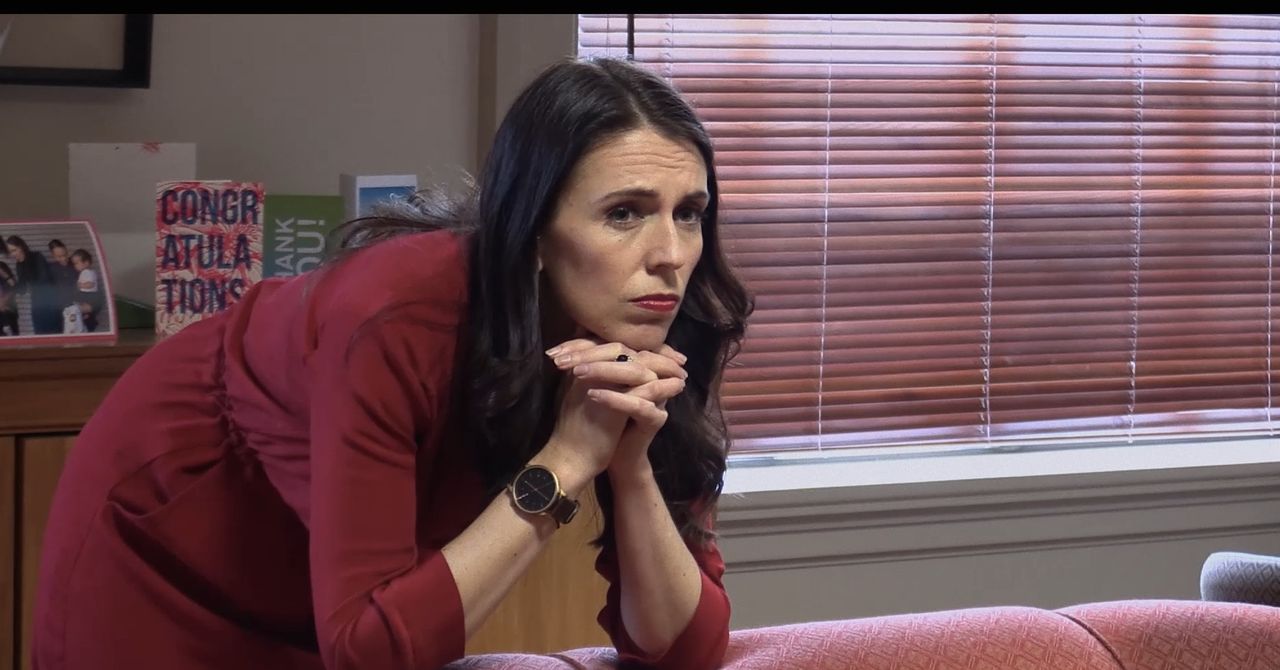Tech
The 36 Best Movies on HBO Max Right Now

As the birthplace of prestige TV shows like The Sopranos and The Wire, HBO—and, by extension, HBO Max—is best known for its impressive lineup of original series. The network has also been upping the ante with feature-length content that is the stuff of Oscar dreams.
Below is a list of some of our favorite films streaming on HBO Max—from Oscar-winning epics to dystopian sci-fi classics. If you decide you’re in more of a TV mood, head over to our picks for the best shows on HBO Max. If you’re looking for even more recommendations, check out our lists of the best movies on Netflix, the best movies on Amazon Prime, and the best movies on Disney+.
Prime Minister
Very little about Jacinda Ardern’s tenure as prime minister of New Zealand could be described as quotidian. She became the country’s opposition party leader just weeks before election day. After she won she discovered she was pregnant and gave birth while still in office, one of very few heads of state in history to do so. During her tenure she navigated the Covid-19 lockdowns and the Christchurch mosque shooting. This documentary, directed by Michelle Walshe and Lindsay Utz, chronicles her meteoric rise, resignation, and life after her time in office.
Bring Her Back
A24’s partnership with HBO continues to ensure that a never-ending stream of fascinating new(ish) indies from around the globe find their way into the Max library. The latest is a totally deranged Australian horror film starring two-time Oscar nominee Sally Hawkins in what might be her most unhinged performance yet. Following the death of their father, teen step-siblings Andy (Billy Barratt) and Piper (Sora Wong) are sent to live in a foster home with Laura (Hawkins), an odd but seemingly well-meaning older woman who is also currently tending to a young mute boy named Oliver (Jonah Wren Phillips). But Andy comes to learn that Laura is harboring some serious trauma of her own—and that he and his fellow foster kids are part of a wild plan to restore normalcy to Laura’s life. The movie takes viewers to dark, unexpected, and often gruesome places as it dissects the power that trauma can have over our lives.
Hereditary
Ari Aster made a splash—and one unfortunately memorable splat—with his 2018 directorial debut, which took psychological horror to new heights. Annie Graham (Toni Collette) is an artist living a seemingly contented life with her psychiatrist husband (Gabriel Byrne) and their two teenaged kids, Peter (Alex Wolff) and Charlie (Milly Shapiro). But any sense of normalcy disappears almost immediately following the death of Annie’s mom, with whom she had an often strained relationship. Is Annie crazy? Is her husband a terrible shrink? Is Peter a terrible person? Why does Charlie make that clicking noise? What’s that in the back seat of the car? These are all valid questions that are answered by Aster, whose deft directorial style has made him an instant Hollywood icon. Aster’s follow-up films, 2019’s equally disturbing Midsommar and 2023’s surrealist Beau Is Afraid, are also both available to stream.
The Witch
Anya Taylor-Joy was a 19-year-old Hollywood newcomer when she delivered her breakthrough performance as Thomasin, the young daughter of a family that is banished from its Puritan community in 1630s New England and forced to live in solitude in the wilderness. Soon they begin experiencing a series of eerie encounters that they believe to be supernatural in origin—and they very well may be right. The film, which burns slowly but brilliantly toward a conclusion that rewards viewers’ patience, marked the feature directorial debut of writer/director Robert Eggers, who has gone on to wide acclaim for similarly moody flicks like The Lighthouse (2019), The Northman (2022), and Nosferatu (2024).
Shame
Two years before nabbing the first of two (and counting) Oscar nominations for his work on Steve McQueen’s 12 Years a Slave, Michael Fassbender and McQueen collaborated on the criminally underseen Shame. To be fair: the film’s NC-17 rating certainly didn’t help its chances at becoming a box office behemoth, but the controversial rating was necessary in order for McQueen to deliver such a raw and honest portrayal of addiction. Brandon Sullivan (Fassbender) is a handsome and powerful executive living the good life in New York City, all while attempting to hide a debilitating sex addiction that has quickly taken over every part of his life. But when Brandon’s sister Sissy (Carey Mulligan) shows up at his apartment unexpectedly, she forces him to confront the ties—and trauma—that bind them.
Friendship
Paul Rudd and Tim Robinson both do what they do best—be impossibly likable and incredibly unhinged, respectively—in this dark comedy bromance. Craig Waterman (I Think You Should Leave’s Robinson) is an awkward marketing executive who is surprised when his new neighbor Austin Carmichael, a local TV meteorologist, invites him over for a beer one night. The two strike up an unexpected friendship that has the typically homebound Craig seeing the world in a whole new way—one filled with guys’ nights and male bonding. But when Austin decides to call off their brewing brotherhood, Craig cannot handle the rejection. And will go to wild lengths to mend their relationship.
Se7en
What’s in the box? If you don’t know, you’re about to find out. If you do know, it’s still worth rewatching. Gwyneth Paltrow was simply known as Brad Pitt’s girlfriend when this clever thriller was released in 1995, and Kevin Spacey was a hot commodity fresh off his Oscar win for The Usual Suspects. How times have changed! But this David Fincher classic, about a serial killer whose North Star is the seven deadly sins, remains a gritty masterpiece that has lost none of its potency in the 30 years since its release. Warning: It’s scheduled to leave the service on October 31, so get to (re)watching.
Final Destination Bloodlines
Twenty-five years after Final Destination arrived in theaters, and more than a decade after the last installment, the newest entry in the so-bad-it’s-good horror franchise just delivered what is undoubtedly its best chapter. While the story follows the same plot that fans have come to know and love—a group of people manage to cheat death, so Death comes back to finish the job—this one gives some history to that familiar rubric. While that gives this entry a more emotional level, it’s also quite clever in the new ways it chooses to off those whose fate was predetermined. And while it’s gory as hell, there’s something subtly comedic about the whole affair.
Sinners
Hot on the heels of some of the best, and most successful Marvel movies ever (that would be the Black Panther films), writer-director Ryan Coogler found a whole new way to blow cinephiles’ minds with this gorgeous vampire tale. Set in 1930s Mississippi, the film stars Michael B. Jordan in a dual role as twin brothers Smoke and Stack, two World War I veterans who return home from Chicago with mob money with a plan to run a juke joint. Opening night of their new establishment, however, goes terribly wrong when a group of blood-sucking white musicians shows up at their door. Lush and full of beautifully shot action scenes, Sinners is already headed to the top of most Best of 2025 lists. In addition to the original theatrical release, HBO Max is streaming the film in Black American Sign Language (BASL).
Get Out
In 2017, Jordan Peele went from one half of Key & Peele to an Oscar-winning screenwriter (not to mention the first Black writer to win the Academy Award for Best Original Screenplay and the first Black filmmaker to be nominated as a producer, writer, and director in one year). Eight years later, the impact of Peele’s Get Out is still just as impressive. Chris (Daniel Kaluuya) has been invited by his girlfriend, Rose (Allison Williams), to spend the weekend at her parents’ home in upstate New York. While Chris worries that her seemingly upper-class parents won’t be accepting of an interracial relationship, Rose assures him it won’t be a problem—and she’s right, but for all the wrong reasons. With Get Out, Peele cracked the code on making a film that was a horror movie, psychological drama, and telling commentary on race all at once.
Parasite
Even if you don’t care about awards, the fact that Parasite is the first—and still only—non-English-language movie to win a Best Picture Oscar should tell you something about the universality of its themes. The Kims, a family struggling to make ends meet, set their scheming sights on the Parks, a well-to-do family with plenty of problems of their own, but also plenty of money to muffle their dysfunction. At least for a time. Just when you think you know how class warfare is playing out in this black comedy, it changes course to reach an unexpected conclusion. As always, director Bong Joon-ho knows just how to lead his audience down one path, only to open a trapdoor into another.
Mountainhead
Succession creator Jesse Armstrong just might be today’s foremost chronicler of the world’s 1 percent. He stays in that lane with Mountainhead, his feature directorial debut, which follows an unexpectedly eventful weekend gathering of four of the tech world’s most powerful men at the new mountain retreat of Hugo “Souper” Van Yalk (Jason Schwartzman), the only non-billionaire of the bunch. While it’s meant to be a friendly get-together between old pals, everyone has an ulterior motive for blocking the weekend on their calendar. But all plans go out the window when the social media platform owned by Ven Parish (Cory Michael Smith), the world’s richest man, sends the world into upheaval as the result of a fast-tracked AI feature that’s spreading disinformation at an alarming rate. Which everyone but Ven sees as an opportunity to increase both their power and net worth.
Babygirl
Romy Mathis (Nicole Kidman) is a high-powered CEO with a husband (Antonio Banderas) who does not excite her and two teenage daughters she adores. But her life is turned upside down when one morning, while walking to her office, she is nearly attacked by a dog. A handsome young stranger (Harris Dickinson) steps in and manages to avert the attack, which leaves Romy shaken—and curious. Later, that same young man is introduced to her as Samuel, one of her newest interns, who seems to keep finding ways to push the boundaries of appropriate workplace behavior. Eventually, Romy gives in to Samuel’s advances, and his taste for BDSM-ish kink. Despite Romy’s concerns about the unfair power dynamic, Samuel insists that he’s the one who holds the power in their relationship, as she is the one with everything to lose. He might be right about that.
The Brutalist
Adrien Brody earned his second Best Actor Oscar for this historical epic from director Brady Corbet about László Tóth (Brody), a Bauhaus-trained architect who emigrates to America after surviving the Buchenwald concentration camp. Tóth settles in the Philadelphia area and must rebuild his life by working menial jobs for little pay. But Tóth’s talents don’t go hidden for long. A wealthy industrialist, Harrison Lee Van Buren (Guy Pearce), learns about Tóth’s past and commissions him to design a huge project. He also helps to speed up the immigration of Tóth’s wife, Erzsébet (Felicity Jones), whom he has not seen since his incarceration. But Tóth soon learns that the American Dream comes at a price. While, at its heart, The Brutalist is a frank depiction of the immigrant experience, it’s also a heartbreaking statement on the pain that comes with processing trauma. The film won three of its 10 Oscar nominations, and is completely deserving of each.
House
Prepare to have your mind blown by this trippy 1977 horror-comedy from Japan. Gorgeous (Kimiko Ikegami) is the daughter of a famed film composer who returns from a trip to Italy with a surprise: a new wife. In an effort to avoid the awkwardness of the situation, she asks her aunt if she can stay at her creepy old mansion for the summer, then brings along six of her closest friends. It doesn’t take long for weird things to start happening. Disembodied head attacks, homicidal pianos, and possessed cat portraits? This thrillingly bonkers cult classic has it all!
Gimme Shelter
Legendary documentarians Albert and David Maysles reinvented the rockumentary with this riveting first-hand recounting of the final days of the Rolling Stones’ 1969 US tour, which led to their infamous Altamont Free Concert. The concert, which attracted an estimated 300,000 people to California’s Altamont Speedway on December 6, 1969, was a disaster from the get-go—especially given the band’s decision to bring in the Hells Angels as the show’s security (one member famously said they were reportedly paid in beer). The Stones weren’t the only artists, but by the time they took the stage the crowd was out of control. At one point, one of the Angels stabbed a man, Meredith Hunter, right in front of the stage—a moment that the filmmakers later realized they had captured on film. Seeing the band’s reaction to watching the footage themselves makes for a truly compelling perspective on rock stardom.
Sing Sing
Colman Domingo proves yet again why he is one of today’s most acclaimed actors with this Oscar-nominated performance. Divine G (Domingo) is an inmate at New York’s infamous Sing Sing prison, serving time for a crime he did not commit. During his imprisonment, he finds purpose and joy in the prison’s theater group, part of its (very real) Rehabilitation Through the Arts program. By tapping into his inner thespian, Divine G is able to connect with his emotions, and he becomes determined to prove his innocence. But his undeniable acting talent, which inspires some of his fellow inmates, ends up posing a problem when it comes time for a parole hearing. Ultimately, Divine comes to respect the transformative power of the arts in helping him and some of his fellow inmates to overcome their past traumas. Making the film even more powerful is the fact that many of the actors are formerly incarcerated men who took part in the program.
Heretic
Hugh Grant earned some much-deserved awards consideration for playing so far against type in this religion-themed psychological thriller. Sister Barnes (Sophie Thatcher) and Sister Paxton (Chloe East) are two young Mormon missionaries who are desperate to find someone—anyone—who will let them speak about their religion in an attempt to convert new members to the church. When Mr. Reed (Grant), a seemingly kind older man, invites them into his home in order to deliver their spiel to him and his wife, it quickly becomes apparent, at least to Sister Barnes, that something is amiss. And that Reed doesn’t so much want to hear about religion as he does talk about it—and force his own beliefs on the young women in increasingly bizarre, and deadly, ways.
We Live in Time
Andrew Garfield and Florence Pugh ignite the screen with their chemistry in this romantic tearjerker that follows the couple over the course of a decade, from their meet-not-so-cute (she hits him with her car) to their journey into parenthood and, eventually, facing the ultimate curveball that threatens their happily-ever-after. Garfield and Pugh are two of the most acclaimed actors of their generation, and We Live in Time proves why.
Juror #2
Up until now, most of what you’ve heard about Juror #2 is how it’s one of Clint Eastwood’s most accomplished directorial efforts—and yet somehow it got shafted when it came to its theatrical release. Now’s your chance to see what all the fuss is about. Justin Kemp (Nicholas Hoult) is a journalist and recovering alcoholic who is making every effort to maintain his sobriety. That becomes a bit of a challenge when he’s put on the jury of a high-profile murder trial … only to realize that he may have inadvertently played a part in what happened. Hoult is fantastic in this edge-of-your-seat legal (and ethical) drama.
Beetlejuice Beetlejuice
It has been nearly 40 years since Tim Burton’s Beetlejuice stormed the late ’80s box office. In the decades since, we’ve often heard rumblings that a sequel was in the works. Or might be in the works. Or most definitely was in the works. Or might not be in the cards at all. Well, in 2024 it finally happened, and it was as if Michael Keaton had never stepped away from the role at all (eternal life has a way of doing that to you). This time, however, Lydia (Winona Ryder) is still doing her best to forget her rendezvous with the bio-exorcism pro. But when she returns to her childhood home, it’s her own badass daughter (Jenna Ortega) who finds a way to bring him back into all their lives.
Super/Man: The Christopher Reeve Story
In addition to the all-new Superman movie, audiences have James Gunn and his DC Studios co-CEO Peter Safran (partly) to thank for bringing this long-overdue documentary about the ultimate superhero actor to worldwide audiences. Directors Ian Bonhôte and Peter Ettedgui deliver a heartfelt, moving tribute to Reeve—as an actor, yes, but even more so as a person who never gave up. Alexandra Reeve Givens, Matthew Reeve, and Will Reeve—Reeve’s children—share their own stories about their dad, giving the project yet another layer of intimacy. No, you’re crying.
Watchmen: Chapter I
Brandon Vietti (Batman: Under the Red Hood) directs this innovative animated adaption of Alan Moore’s Hugo Award-winning graphic novel about an investigation into the murder of Edward Blake—better known as a superhero named the Comedian. When the police come up empty in terms of suspects, the costumed vigilante Rorschach (Titus Welliver) decides to take the case into his own hands, and eventually comes to believe that someone is attempting to knock off superheroes. So he enlists the help of a group of them in order to put a stop to the killing spree.
MaXXXine
MaXXXine is the third film in writer-director Ti West’s X trilogy, which began with X and Pearl. It’s set immediately after the events of Pearl: Mia Goth’s Maxine Minx is desperate to escape her upbringing as a preacher’s daughter and make the move from porn to more mainstream movies. She gets her chance when she lands the lead in a horror movie, The Puritan II. Then her friends start getting murdered. Ultimately, Maxine is forced to confront the sins of her past and find a way to achieve the fame she so desperately dreams of.
Civil War
In the not-too-distant future, the United States has transformed into an all-out battlefield between an authoritarian government, headed by a third-term president (Nick Offerman), and a stream of secessionist movements that threaten to destroy the country as we know it. But a group of journalists (led by Kirsten Dunst) is determined to document the downfall of America at any cost, so they set about heading to the White House in order to interview the embattled president. Which is much easier said than done. Oscar nominee Alex Garland (Ex-Machina) writes and directs this dystopian drama that often hits uncomfortably close to home.
Furiosa: A Mad Max Saga
Furiosa may have been dubbed last summer’s first box office “bomb,” but don’t let those dollar-focused headlines deter you from this one. Anya Taylor-Joy, who is undoubtedly one of the most versatile actors working today, shines in the role of Imperator Furiosa, a badass emancipator who dares to challenge gender conventions in a dangerous, postapocalyptic world where (no surprise at all) men make the rules. Taylor-Joy does an admirable job embracing the role that Charlize Theron memorably originated in Mad Max: Fury Road.
Love Lies Bleeding
English writer-director Rose Glass follows up her BAFTA-nominated Saint Maud with this twisty, hyper-violent love story. It’s 1989 in a rural New Mexico town where gym manager Lou (Kristen Stewart) is doing her best to stay under the radar and keep an eye on her sister Beth (Jena Malone), who is in an abusive relationship with her husband JJ (Dave Franco). But Lou’s life is turned upside down when Jackie (Katy O’Brian), a gorgeous young bodybuilder, begins coming to Lou’s gym to train for an upcoming competition in Las Vegas. The two fall in love—and then Lou’s hidden family secrets come tumbling out of the closet and threaten her life, and the lives of those she cares about.
Faye
“I’m Faye Dunaway. That’s who I am.” That’s the way the Oscar winner introduces herself in the trailer for Laurent Bouzereau’s feature-length documentary. But what the film reveals is that there’s a lot more to Faye Dunaway than the glamorous image associated with the legendary star of Network. Dunaway opens up in a way that has rarely been seen before, discussing her childhood and family, her struggles with bipolar disorder, and how the characters she has played continue to impact her. It’s a fascinating portrait of a true Hollywood icon.
Quad Gods
Jess Jacklin’s feature documentary follows the fascinating journey of Blake, Prentice, and Richard—three individuals with quadriplegia who meet in a neuro-rehabilitation lab at Mount Sinai Hospital and launch a plan to create the world’s first all-quadriplegic esports team. It’s a noble pursuit, but one fraught with challenges as they break down the doors of ableism. At its heart, Quad Gods is a story of friendship, perseverance, and survival.
Am I OK?
Lucy (Dakota Johnson) is a thirtysomething living in Los Angeles, constantly failing at relationships and wondering why she doesn’t have everything figured out yet. After drunkenly sharing the story of the time she kissed a female friend as a teen, she begins to realize that the problem in her love life might not be the men she’s choosing, but that she’s choosing men at all. Former Saturday Night Live writer Lauren Pomerantz penned the script for the film based on her own experience of coming out in her thirties. Tig Notaro and her wife Stephanie Allynne do an admirable job as codirectors, treating Lucy’s journey of self-discovery with the respect it deserves—and plenty of humor.
MoviePass, MovieCrash
For better or worse, millions of film fans will remember 2012 as the year of MoviePass. For $25 per month, you could basically live in a movie theater—which was great for audiences, not so great for movie theaters (which were already struggling), and eventually disastrous for the company itself. For anyone who still has their MoviePass, this revealing documentary tells the real story of all that went wrong behind the scenes, and shares the story of the unsung heroes who really did just want to create a product that movie lovers could embrace. By the way: If you do indeed still have your original MoviePass, this doc has made it a worthwhile piece of memorabilia—with some selling for north of $1,000.
Dune and Dune: Part Two
Since breaking through with the Oscar-nominated Incendies (2010), Denis Villeneuve has continued to prove that he’s one of the most talented filmmakers working today. As if making a Blade Runner sequel that didn’t suck wasn’t enough, Villeneuve then went on to crack the cinematic code on Frank Herbert’s Dune series—something that true visionaries like David Lynch and Alejandro Jodorowsky had attempted before him, albeit largely unsuccessfully. Both the 2021 original film and its sequel are streaming on HBO Max—as is Lynch’s 1984 adaptation (which has become a bit of a cult classic over the years). The film follows the fate of the planet Arrakis—and its supply of melange, a unique spice and the most valuable substance in the universe—which rests in the hands of Paul Atreides (Timothée Chalamet), the untested son of a powerful duke. Looking for more Dune action? The prequel series Dune: Prophecy, starring Emily Watson, Olivia Williams, and Mark Strong is streaming in full.
The Zone of Interest
In 1943, Rudolf Höss (Christian Friedel) was the commandant of Auschwitz who spent his days playing god with the lives of the concentration camp’s innocent prisoners. But what happened when Höss went home? That’s the reality Jonathan Glazer’s Oscar-winning film examines, and the answer is: Not much. Höss lives right next door to the camp, in the so-called Zone of Interest, with his wife Hedwig (Sandra Hüller) and their five children. Within those four walls, they strive to build a dream life for their family—while the sound of gunshots, incoming trains, and furnaces being lit are just a part of daily life. Yes, it’s every bit as brutal—and necessary—as it sounds.
Barbie
Greta Gerwig is a master of breathing new life into old properties (see: Little Women). With Barbie, she has ignited a revolution. Barbie (Margot Robbie) is living her best life in Barbieland—until one day, when her perfectly plastic world, and heels, suddenly begin to collapse. To get her fabulous life back, Barbie must travel to the real world—well, Los Angeles—to determine who or what is causing her existential crisis. The film grossed nearly $1.5 billion worldwide, meaning you’ve already seen it. But even if you did, it’s absolutely worth a second watch—if only to lament its many Oscar snubs.
Reality
In 2017, an intelligence report about Russian interference in the 2016 US presidential election was leaked anonymously. One year later, former NSA translator Reality Winner (yes, that’s her real name) was sentenced to more than five years in prison for the crime—the longest sentence ever received by a government whistleblower. HBO’s reigning muse, Sydney Sweeney (Euphoria, The White Lotus), shines in this gripping true story, which plays out mostly in real time as the FBI knocks on the 25-year-old’s door and spends more than an hour questioning her.
All the Beauty and the Bloodshed
Finding success in one’s lifetime might seem like the dream of every artist, but Nan Goldin has bigger ambitions. Though she’s a photographer by trade, she’s an activist by calling and has long used her camera to capture painfully intimate moments of America in crisis, including extensive work focused on the HIV/AIDS and opioid epidemics. But All the Beauty and the Bloodshed reveals the artist in conflict: Should she allow her work to be showcased in one of the prominent museums or galleries that have received endowments from the Sackler family—the Big Pharma family that many blame for America’s opioid crisis? It’s a moving portrait of an artist willing to risk it all for her beliefs.
Tech
Lectra appoints John Brearley as president of Americas

Lectra, leader in industrial intelligence technology solutions for players in fashion, automotive, and furniture, announces the appointment of John Brearley as President, Americas, effective October 1, 2025. He becomes a member of the Group’s Executive Committee.
Lectra has appointed John Brearley as president, Americas, effective October 1, 2025.
A 40-year industry veteran and long-time Lectra leader, he will join the executive committee and oversee operations in a region contributing 33 per cent of sales.
Brearley aims to drive growth, strengthen customer ties, and support digital transformation across fashion, automotive, and furniture markets.
Lectra currently operates in 31 countries in the Americas region, with 400 employees in 7 locations – including Tolland, one of the Group’s three production sites – and more than 8,000 customers. The Americas play a crucial role for Lectra, contributing to 33% of the Group’s sales in 2024 and serving a diverse portfolio of customers in the fashion, automotive, and furniture industries, as well as in other industries.
“We look forward to John Brearley continuing his impactful journey within the Group as he steps into this pivotal leadership role”, says Daniel Harari, Chairman and Chief Executive Officer of Lectra. “With his extensive experience in the industry and a proven track record of leading our teams to support our customers and drive growth in Lectra’s recurring business, John is well-positioned to lead our Americas teams toward accelerated growth, strengthened customer relationships, and achieve our strategic objectives.”
Throughout his 40-year career, John has played an instrumental role in shaping a responsive, customer-centric culture within the organizations he has served. He began at Investronica where he managed the business in the UK, before moving to the US in 2001 to lead the North American division. Following Investronica’s acquisition in 2004 by the Lectra group, John took over the responsibility of growing the Consumables and Parts activity. His expertise in customer relations earned him the role of Vice President of Customer Care for Lectra Americas in 2007. In 2020, John was promoted to Senior Vice President of Customer Success for the region.
“It is an honor to take on this new role at such a strategic moment for Lectra and our customers in the Americas”, says John Brearley. “My focus will be on supporting customers and ensuring that we empower them not just to meet the challenges of Industry 4.0, but to thrive—growing more resilient, agile, and sustainable through every step of their digital transformation.”
Note: The headline, insights, and image of this press release may have been refined by the Fibre2Fashion staff; the rest of the content remains unchanged.
Fibre2Fashion News Desk (HU)
Tech
I Keep Cooking Thanksgiving! Here’s the Best Holiday Meal Delivery

Making a full Thanksgiving feast for guests can be daunting, for some perhaps even terrifying. The world, and especially Hallmark movies, is full of holiday disaster stories: burnt turkeys, failed desserts, steamed hams. But I’m not bragging when I say that the first Thanksgiving dinner I prepared for my extended family—a little early, this year—was an unmitigated success.
My aunt couldn’t stop talking about the black pepper in the biscuits and the sage on the carrots. My uncle went in for the turkey and the apple-sausage stuffing. My father didn’t speak at all, unless prompted. He just ate and ate. This was a compliment.
But of course, I had cheated. I had ordered my Thanksgiving in the mail—one of the new breed of Thanksgiving meal kits.
The meal was genuinely home-cooked, of course, prepared mostly from scratch. But the entire seven-platter feast—its ingredients and recipes—had arrived two days before, in a box large enough to house a primal cut of beef. It was Thanksgiving in a box: a $200 “Chef’s Table Thanksgiving” meal kit available from sister meal delivery plans Sunbasket and Gobble.
The spread from Sunbasket was vast and generous. The table contained a nearly 3-pound roast of turkey, mounds of mashed potato, pebbled cranberry compote, roasted carrots dressed in miso-sage butter, brussels sprouts dappled with pecorino romano and pancetta, an endless platter of fennel-apple-sausage-stuffing, Gruyère black-pepper biscuits caked more than an inch tall, a tureen of deep brown turkey gravy, a ginger apple crisp waiting in the wings.
Sunbasket is among a new bounty of meal kit companies that aim to ease the stress of the holidays by doing the planning and the shopping for you—big meal boxes tailor-made for those who still want to make a home-cooked meal but for whom the prospect of planning a vast and complicated feast is prohibitive. In fact, two weeks later I cooked another Thanksgiving meal from Blue Apron, this time for my sister’s family.
Here was my experience with Sunbasket and Blue Apron—and some of the other Thanksgiving meal delivery options to get your whole Thanksgiving meal delivered to your home.
Want meal kits for more everyday occasions? See WIRED’s guides to the best meal delivery services, and the best plant-based meal delivery kits.
The Blue Apron à la Carte Thanksgiving (and Holiday) Meal Kit
Available till December 29. Order by November 19 to ensure delivery by Thanksgiving.
Blue Apron, one of the OG meal kits in the US, has undergone a wholesale transformation this year. One of the biggest changes is that subscriptions are no longer required, and à la carte meal ordering is possible—indeed, it’s now my favorite no-subscription meal kit offering. What this means is that for this Thanksgiving, you can order individual Thanksgiving recipe kits to prep fresh at home, without ever setting foot in a crowded grocery store.
That means roasted grape and goat cheese salad ($12), a big ol’ turkey breast with gravy and cranberry sauce ($50), rosemary herb stuffing ($15), a truly excellent casserole worth of truffle-oiled Southern mac and cheese ($20), almond apple crumb pie ($15), brown butter mashed potatoes ($8), challah rolls with maple ($8) and roasted brussels sprouts with pistachios, ($10). I made all of these recipes for my sister’s family and our parents, a little early this year—and it was a surprisingly delicious feast fit for at least eight people. Probably even 10, if you add an extra order of mashed potatoes.
Tech
The Best Binoculars Will Help You Find the Ivory Billed Woodpecker

You get good magnification, with a waterproof (IPX7 rating) and fogproof design in a lightweight package (11.8 ounces). These also have two things that specifically make them great for kids: rugged construction and a nice, rubberized grip. I can’t tell you how many trees and rocks these have bashed into while around my son’s neck, and they’re still as good as new.
Stargazing Binoculars
When you think stargazing you probably think telescopes, but binoculars can work too, especially larger, higher-magnification models like these Celestron Skymasters. The first thing to know is that these are huge—most of the time you’ll want to use them with a tripod, which is not included in the price (they do include an adapter, which I used to put them on a photo tripod, which worked fine). The Porro prism design (see above), with 15x magnification and 70mm objective lenses, make these nice and bright, perfect for getting good views of the moon. They also work for larger clusters and nebulae. They do work for birding as well, but it’s more like using a spotting scope. They’re nice for digiscoping, though if you’re viewing something reasonably stationary, like water birds.
As with all Celestron binos there’s a nice big, smooth focusing knob, and they also have long eye relief which makes them easy to use with glasses. There is a fair bit of chromatic aberration, especially with bright stars or the moon, but I didn’t find it distracting. In fact, for the price, these provide surprisingly great views.
Image-Stabilizing Binoculars
Image-stabilized binoculars use electronics to smooth out your view, similar to what action cams do to get rid of jittery video. There are quite a few models out there, and we are still testing, but here are a few that have stood out from the pack so far.
Image-stabilized binoculars tend to be expensive, but Canon has quite a few budget models worth considering. They’re simple to use. You just tap the button on top for five minutes of stabilization, or tap again to turn it off sooner. The tech detects your movement and adjusts for it optically, in real-time. The Canon 8×20 IS, its smallest, is doubly pocket-friendly: They’re surprisingly affordable and fit in a large pocket. At 15-ounce plus battery, they won’t weigh you down.
The 8X magnification is good for wildlife and sports, as is the 10X magnification of the only slightly larger Canon 10×20 IS. The 6.6-degree field of view is narrow but wide enough for most situations.
-

 Tech1 week ago
Tech1 week agoFrom waste to asset: Turning ethanol production CO₂ into jet fuel
-

 Tech4 days ago
Tech4 days agoNew carbon capture method uses water and pressure to remove CO₂ from emissions at half current costs
-

 Politics5 days ago
Politics5 days agoBritish-Pakistani honoured for transforming UK halal meat industry
-

 Sports3 days ago
Sports3 days agoTexas A&M officer scolds South Carolina wide receiver after touchdown; department speaks out
-

 Business4 days ago
Business4 days agoThese 9 Common Money Mistakes Are Eating Your Income
-

 Tech1 week ago
Tech1 week agoSecurity flaws in portable genetic sequencers risk leaking private DNA data
-

 Business4 days ago
Business4 days agoWhat’s behind Rachel Reeves’s hokey cokey on income tax rises?
-

 Politics6 days ago
Politics6 days agoInternet freedom declines in US, Germany amid growing online restrictions

















-SOURCE-Caramel-Quin.jpg)




